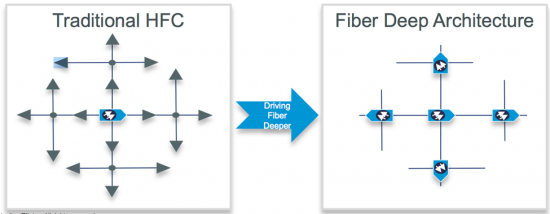































 Written by Tim Brophy, Product Manager Cable Access Business Unit
Written by Tim Brophy, Product Manager Cable Access Business Unit
More and more these days, service providers in the access market are talking about the evolution of their plants to a Fiber Deep (FD) Architecture. While the trend toward driving fiber into the plant and reducing RF amplifier cascades is not new, today's discussions seem to be a harbinger of much more significant changes in the distribution plant. The changes are not only to the physical equipment, but are also shifts in both the management and the day-to-day operation of the access network. But what exactly is fiber deep and what are the changes it implies?
To appreciate the significance of fiber deep, it is useful to understand a few things. First, we need to describe the physical changes to the access plant, and the impact that has on both the operator and their customers. Next, we need to identify those operational changes that drive anticipated installation, maintenance, and troubleshooting improvements for the future. Finally, we need to look to the services and application delivery ecosystem that help a service provider navigate the options to capitalize on the benefits of fiber deep and better quantify the return on investment.

At its most basic physical level, FD architectures move the optical node (the optical-to-electrical conversion point) deeper into the network and closer to the subscriber. Often also called N + 0 (for node + 0) architectures, the FD node location eliminates the RF amplifier cascades of the traditional HFC outside plant. It is worthwhile to distinguish this from a Fiber to the Last Active (FTLA) architecture, in which the final amplifier in each cascade is simply replaced with a node. The FD designs places nodes at locations chosen to equalize the number of subscribers served and minimize the disruption of upgrades. In this way, the number of new nodes and the plant efficiency (in terms of failure group size, powering, and underutilized hardware) is optimized.
Some advantages of the FD architecture are obvious: the potential 60% reduction in plant actives and commonality of hardware reduce maintenance costs and improve reliability. The changes still let a field technician leverage the familiar HFC tools and techniques. Operationally, smaller service groups increase per subscriber capacity and frees spectrum to provide new or additional services. That smaller service group combined with shorter RF cascades reduces noise in both directions, improving downstream MER (for higher order modulation efficiency gains) and reduced noise funneling in the reverse plant. But the FD topology also increases options for flexible growth. The location is optimal for aggregation and splitting of signals, laying the groundwork for Remote PHY or FTTx deployments, while keeping green initiatives and reduced energy impacts in mind.
Fiber deep plants are just one step in an overall transition of the access architectures. As operators strive to configure services and deploy applications dynamically, robust and operationally simple networks become critical. For end customers, on-demand applications and rapid fulfillment determine their perceived quality of experience. When combined with improvements in network orchestration permitting dynamic configuration, improved modulation, and device and protocol-independent deployments, FD provides a stepping stone to the reliable and flexible link necessary for competitive success. Your Cisco account representative can help guide you through the options and planning for successful architecture implementation.
In future blogs we'll discuss the synergies of FD with Remote PHY and the advent and significance of intelligent nodes spreading throughout the access plant, and highlight improvements in technologies that power this revolution towards Distributed Access Architectures.
See what Cisco have to offer for Cable Access HFC solutions
 Hot Tags :
Service Provider
cable access
remote phy
hfc
rpd
deep fiber
gs7000
inode
Hot Tags :
Service Provider
cable access
remote phy
hfc
rpd
deep fiber
gs7000
inode